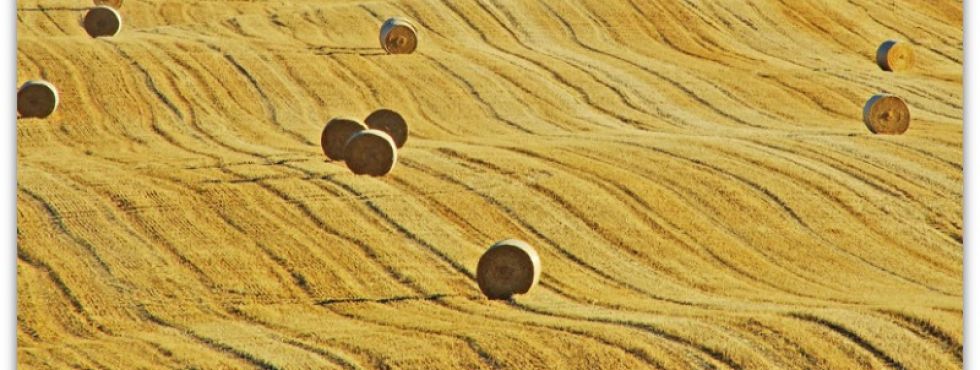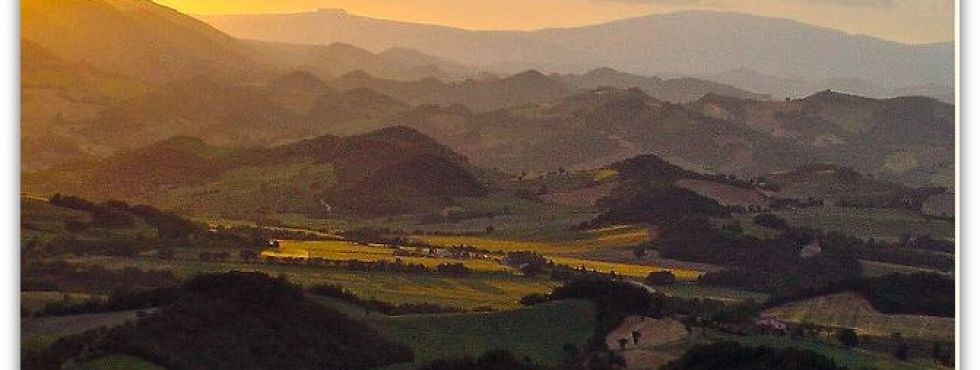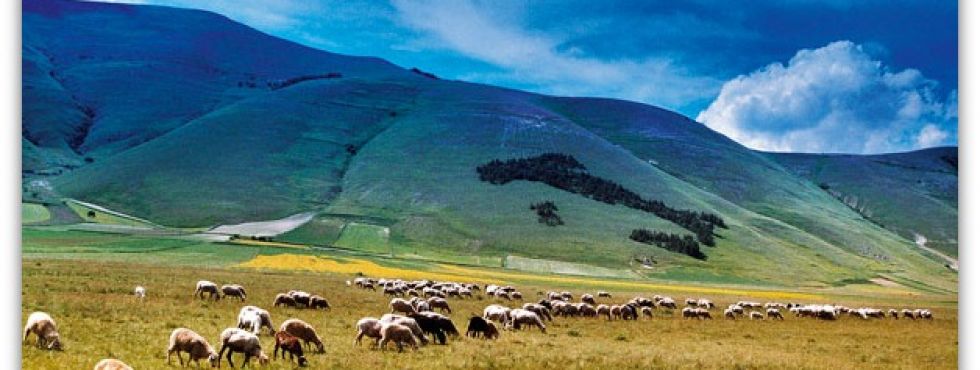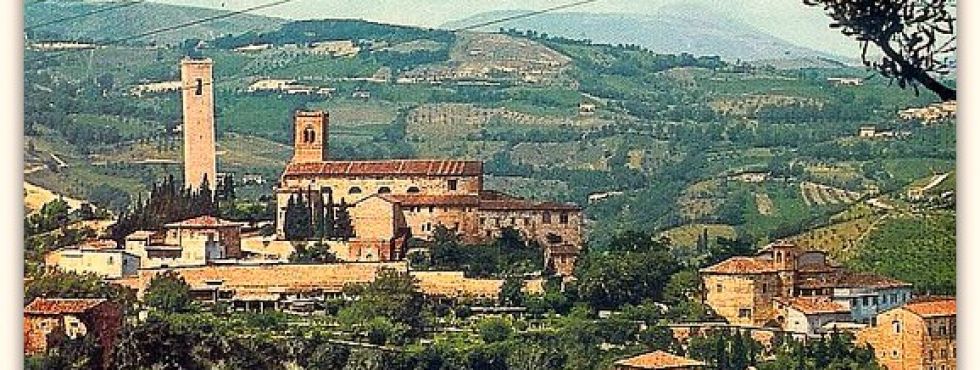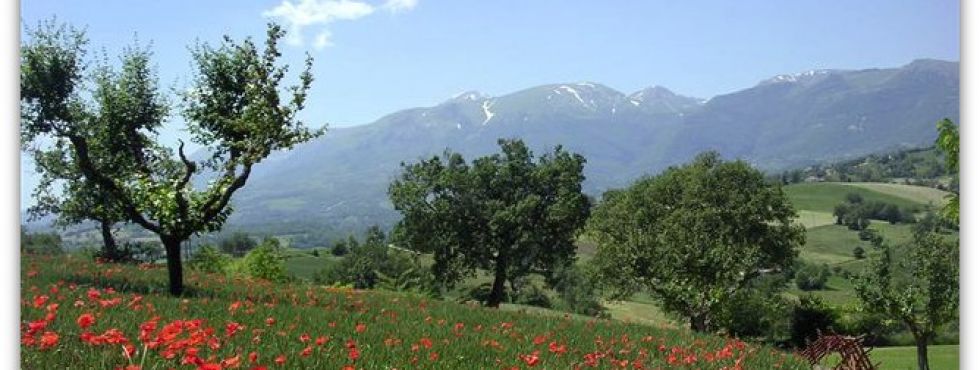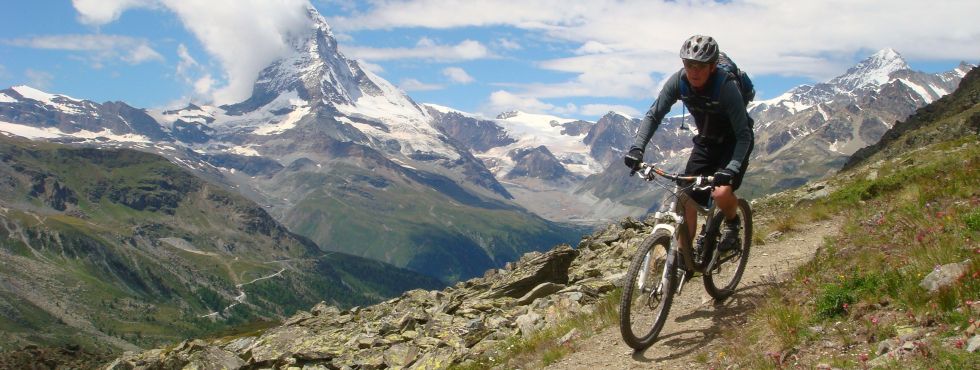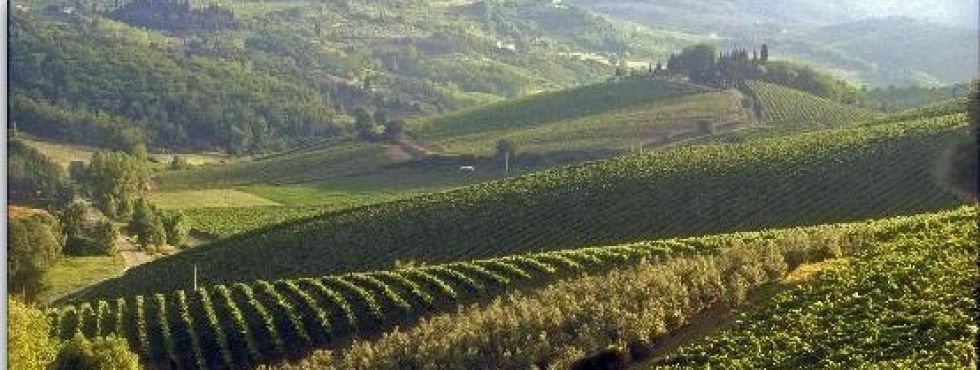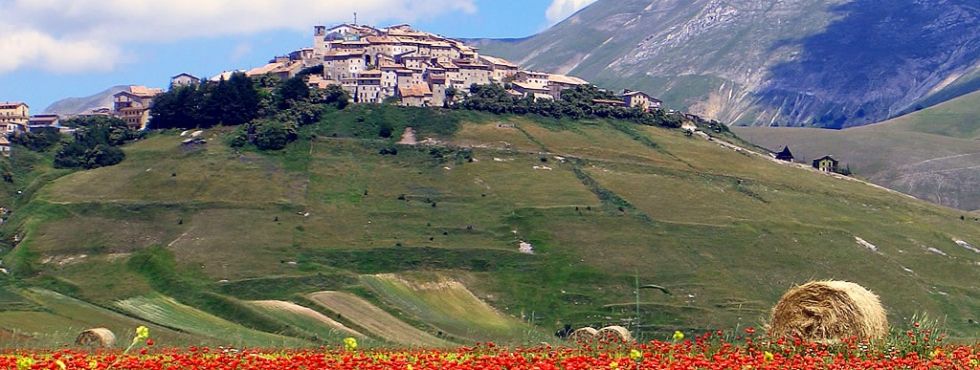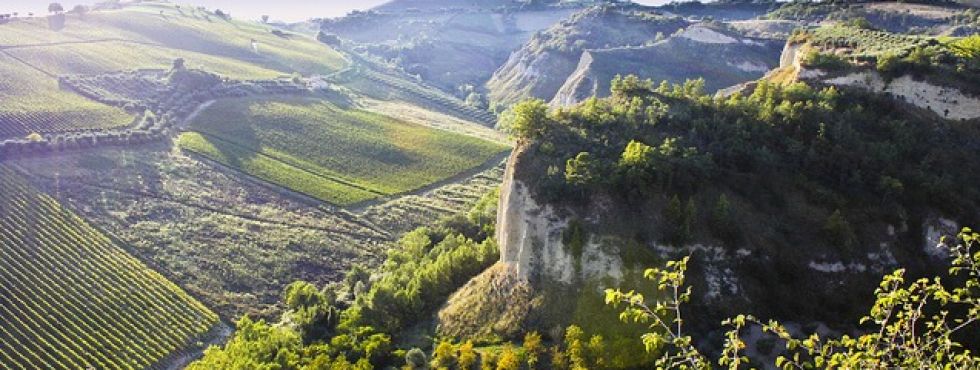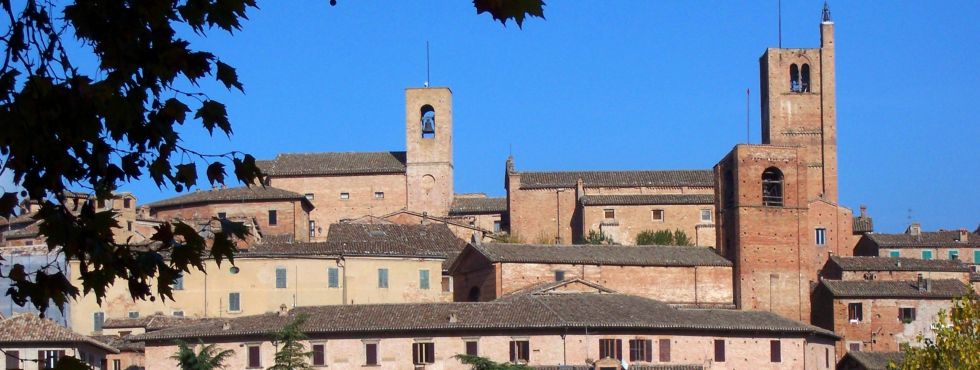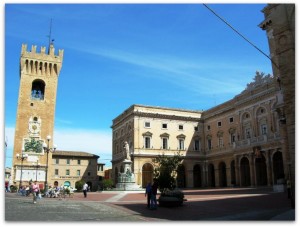 Le Marche – gite per città e borghi
Le Marche – gite per città e borghi
Le città delle Marche offrono scenari molto diversi e tutti affascinanti. Molti borghi medievali fortificati dalle antiche mura sono ben conservati e spesso racchiudono luoghi di ritrovamenti archeologici di resti romani come Urbisaglia e Falerone. Ad Osimo e Loreto si può ammirare l’architettura rinascimentale e Porto S.Giorgio e Civitanova Marche affascinano con le ville in stile Liberty e art nouveaux.
La regione Marche è anche terra di teatri e oltre a tanti piccoli teatri antichi meravigliosamente decorati, vanta la presenza dello Sferisterio di Macerata, una delle più importanti arene d’Italia, dove ogni anno si svolge il Macerata opera festival.
L’agriturismo Fontechiara si trova a mezza via tra i monti Sibillini e il Parco nazionale del Monte Conero, si raggiungono con grande facilità sia la riserva naturale dell’abbazia di Fiastra che il parco delle Grotte di Frasassi, e siamo letteralmente circondati da città e borghi medievali tutti da visitare e ammirare.
Di seguito elenchiamo alcune di queste città e le relative attrattive.
Macerata (20 min )
Macerata è ben conosciuta nel mondo dell’opera lirica per l’annuale open-air opera festival che si svolge da luglio ad agosto nella famosa Arena Sferisterio, che offre posto a 7000 persone.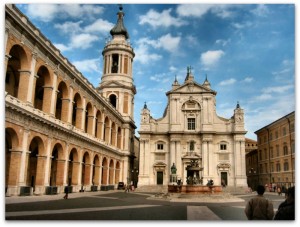
L’arena è stata costruita in stile neoclassico nel 1820, utilizzando fondi privati e l’acustica al suo interno è decantata dagli appassionati di musica. Nulla da invidiare alla più pubblicizzata Arena di Verona.
Il centro di Macerata si trova in cima alla collina ed è stato costruito quasi interamente tra il 16esimo e il 19esimo secolo. Una delle opere architettoniche più impressionante della città è la Loggia dei Mercanti con i suoi portici a due livelli di archi, situata nella centrale Piazza della Libertà.
Dalla Piazza della Libertà si può percorrere Corso Matteotti con i suoi magnifici palazzi mentre Corso della Repubblica arriva in Piazza Vittorio Veneto, dove si trovano la galleria d’arte cittadina e il museo. Qui si possono ammirare molte opere di artisti marchigiani ed umbri come il famoso dipinto “Madonna con bambino” di Carlo Crivelli. Nello stesso palazzo si trovano anche il museo delle carrozze ed il museo dedicato all’unificazione dell’Italia e alla resistenza durante la guerra.
A nord della città, lungo il fiume Potenza, alla congiunzione con la SS571, si trova l’antica Helvia Recina, ed è possibile visitare i resti dell’antica città romana e il grande anfiteatro.
Abbadia di Fiastra (20 min )
Il monastero cistercense di Fiastra è stato fondato nel 1142. Il materiale di costruzione fu fornito dalla vicina città romana Urbs Salvia, e il suo territorio all’epoca si espandeva per 30 km verso la costa. Ancora oggi il terreno e le vigne circostanti vengono coltivati dai monaci ed il vino e altri prodotti sono acquistabili presso l’abbadia.
Il parco dell’Abbadia di Fiastra comprende oltre il monastero medievale anche un museo archeologico e una bellissima riserva naturale aperta al pubblico.
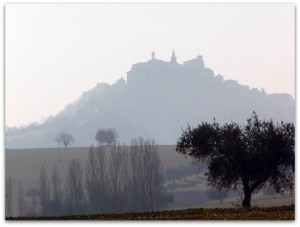 Jesi (40 min )
Jesi (40 min )
Jesi è una delle città più importanti del centro Italia e il suo centro storico è animato da una vivacità culturale inaspettata che ha fatto guadagnare alla città il sopranome “ La Milano delle Marche “.
La caratteristica architettonica più appariscente è un lunghissimo tratto di massicce mura antiche risalenti al 14esimo secolo, costruite su fondamenta romane e fortificate da contrafforti e torri imprendibili.
Le stradine del centro storico percorrono una stretta cresta e sono gremite di negozietti e bar che offrono molte tentazioni ai visitatori.
Nella parte nord-orientale della città si trova Piazza Federico II, dove un tempo sorgeva il foro romano dell’antica Aesis. Vi si trova adesso il Duomo del 18esimo secolo.
Percorrendo per un breve tratto Via Pergolesi si raggiunge Piazza Colocci, dove si può ammirare uno dei palazzi più belli della città, Palazzo della Signoria. Questo edificio rinascimentale è stato costruito alla fine del 15esimo secolo da Francesco di Giorgio Martini, il genio senese ben conosciuto per le sue costruzioni militari.
Il grande leone rampante sopra l’ingresso rappresentava il potere della città. All’interno troviamo un cortile con colonnato a tre ordini, con le colonne del primo livello in mattoni, quelle del secondo livello in marmo e quelle del terzo livello in legno.
Continuando Via Pergolesi, si raggiunge Piazza della Repubblica, la più grande piazza della città con il suo teatro del 18esimo secolo:Teatro Pergolesi, dove ogni autunno si svolge una prestigiosa stagione di opere liriche.
La strada principale ossia Corso Matteotti percorre le vecchie fondamenta romane.
In Via XV Settembre si trova Palazzo Pianetti che ospita la pinacoteca comunale con una piccola collezione di opere di Lorenzo Lotto, da non perdere.
Urbisaglia (20 min )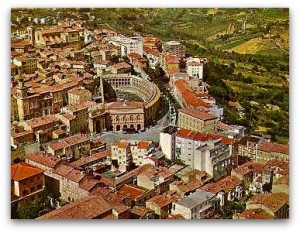
A soli 5 minuti dall’Abbadia di Fiastra si trova il sito archeologico romano di Urbisaglia. E’ possibile assistere ad una visita guidata per vedere il meraviglioso foro affrescato, il teatro e l’anfiteatro, l’antica cisterna per l’acqua, il castello medievale e il museo con i manufatti di origine romana.
Loreto (45 min )
Sulle colline poco distanti dal mare adriatico si trova Loreto, uno dei santuari per la Vergine Maria più importanti del mondo che ogni anno ospita migliaia di pellegrini che arrivano da tutto il mondo.
Il duomo del Santuario della Santa Casa domina il paesaggio circostante ed è visibile anche da grandi distanze. Al suo interno si può ammirare la santa casa di Nazareth, che secondo la legenda arrivò a Loreto nel 1294. La chiesa dichiarò Loreto luogo di pellegrinaggio solo nel 1507 ed i lavori per la costruzione del duomo sono iniziati nel 1468. Il santuario è una vetrina dei nomi più importanti di artisti del tardo rinascimento italiano ed attira anche i non credenti.
Il museo della Pinacoteca conserva una serie di lavori di Lorenzo Lotto, il maestro veneziano che si ritirò e morì nel monastero nel 1556.
Il museo presenta inoltre una collezione rinascimentale di contenitori di ceramica per uso farmaceutico ed in un angolo nascosto ci sono ancora circa 70 blocchi di legno intagliati che venivano usati fino al 1940 per stampare dei disegni sul corpo dei pellegrini che in seguito vennero tatuati come testimonianza indelebile del loro pellegrinaggio a Loreto.
Il comune di Macerata organizza ogni anno un pellegrinaggio da Macerata a Loreto nel mese di giugno
Cingoli (20 min )
La bellissima cittadina di Cingoli si trova in cima ad un colle a 790 m di altitudine e questa posizione sopraelevata unita ad una ampia veduta panoramica gli ha conferito il titolo di “ Balcone delle Marche “.
Salendo Corso Garibaldi si arriva in Piazza Vittorio Emanuele, che è stata costruita sul sito del foro dell’antica Cingulum ed è ancora il cuore della città. Da una parte vi si trova il bel municipio rinascimentale del 16esimo secolo con una torre ad orologio molto più antica. Al suo interno c’è il museo archeologico. Per visitarlo bisogna rivolgersi alla Biblioteca comunale in Via Mazzini 1. La biblioteca è anche sede della Pinacoteca che contiene alcuni quadri di Lorenzo Lotto.
Vicino a Cingoli si trova un bellissimo lago, il lago di Castreccioni con spiagge e stabilimenti balneari dove noleggiare barche e pedalò ed un fantastico parco avventura con percorsi sospesi in altezza e pareti per le arrampicate e il free climbing per grandi e bambini.
Ascoli Piceno (1.5 h )
La città di Ascoli Piceno presenta un gran numero di torri medievali che dominano il centro storico e la famosa Piazza del Popolo, piastrellata in travertino è senza dubbio una delle più eleganti piazze d’Italia.
L’insieme di meravigliose costruzioni in stile gotico, percorsi incantevoli lungo il fiume, negozi, gallerie d’arte e numerosi bar dove gustare il vino rosso piceno, rendono questa città davvero godibile.
Non tralasciate una visita al Bar Meletti in stile Art Noveaux sulla piazza principale.
Caldarola (25 min )
Caldarola è famosa per il castello molto ben conservato, la cui costruzione iniziò nel nono secolo ed è tuttora proprietà della famiglia Pallotta che lo ha aperto al pubblico. Nei dintorni ci sono altri tre castelli da visitare.
Camerino (35 min )
La città universitaria situata tra le alte colline maceratesi ha una storia che riporta ai tempi del Neolitico. E’ rimasta inalterata fino a raggiungere il suo apice durante il rinascimento, quando la locale famiglia Da Varano governava su un ampio territorio marchigiano circostante.
Sono assolutamente da vedere le chiese, i palazzi, i musei ed i giardini della città.
Amandola (60 min )
Amandola costituisce il punto centrale per visitare il parco nazionale dei Monti Sibillini. Ha una bellissima piazza in stile gotico ed un museo sulla storia rurale.
Tolentino (20 min )
Tolentino è una vivace cittadina medievale e vi si trova il bellissimo Santuario di S. Nicola.
La sua architettura è straordinaria ed in particolare l’antico ponte romano, il campanile sul corso principale ed il Castello della Rancia del 12esimo secolo.
Sono da visitare anche il museo della caricatura e dell’arte umoristica.
Recanati (25 min )
Recanati è una delle città più importanti della provincia di Macerata e fu fondata nel 1150 a partire da tre castelli già esistenti. Nel 1290 la città si autoproclamò repubblica indipendente e nel 15esimo secolo era famosa per la sua fiera internazionale. Nel marzo del 1798 fu conquistata da Napoleone Bonaparte.
E’ il luogo di nascita del tenore Beniamino Gigli e del poeta Giacomo Leopardi e di conseguenza Recanati fu soprannominata “città della poesia “.
Si può visitare la casa natia del poeta ed il teatro Persiani, dedicato a Giuseppe Persiani, nato a Recanati nel 1799, compositore di opere durante la prima parte del 19esimo secolo.
La città si trova immersa tra le colline e la costa adriatica. Durante l’estate Villa Colloredo Mels ospita una favolosa stagione lirica ed espone diversi quadri importanti di Lotto.
Osimo (40 min )
A pochi chilometri da Recanati troviamo Osimo con il suo centro storico dai colori caldi sulla cima della collina e la parte più recente della città ai suoi piedi. I suoi palazzi più belli risalgono al 16esimo e 17esimo secolo ma qua e là ci sono scorci su un passato più remoto dell’antica Auximum dei tempi romani, che tuttora invita ad una bella passeggiata al centro.
Nella sala d’ingresso del Palazzo Comunale, situato nella medesima piazza si trovano una dozzina di statue romane decapitate che un tempo ornavano l’antico foro della città e vennero decapitate durante l’occupazione della città.
In Via Fonte Magna si possono vedere i resti degli enormi blocchi di pietra che costituivano le mura romane. L’attuale piantina della città conserva il disegno dell’antica città romana.
Il duomo del 13esimo secolo in stile gotico – romano presenta una cripta davvero straordinaria e conserva un pavimento a mosaico del medioevo.
La chiesa romana di S. Francesco è stata completamente restaurata ed il santuario è dedicato a S. Giuseppe da Copertino (1603- 1663 ) ed è un importante meta di pellegrinaggio.
S. Giuseppe è il santo patrono di chi deve affrontare un esame e grazie alla sua capacità di levitazione, anche dei piloti. I suoi resti sono conservati in un’urna di cristallo nella cripta.
Nel cuore del centro si trova lo splendido Palazzo Gallo del 16esimo secolo con l’epico affresco del pittore toscano Pomarancio, “Il giudizio di Salomone “(1609).
A pochi chilometri a sud- est di Osimo nella valle del fiume Musone, c’è l’imponente santuario di Campocavallo, uno spettacolare pezzo di architettura del 20esimo secolo in stile neo – gotico.
Dietro l’altare si trova una venerata immagine della santa vergine che nel 1892 fu vista piangere dai fedeli e da allora pare che il fenomeno si sia ripetuto diverse altre volte.
S.Severino ( 20 min )
Fu fondata nel 550 dopo che l’antica Septempeda romana era stata distrutta dai goti.
L’incantevole cittadina mostra una grande varietà di costruzioni medievali e rinascimentali.
La sua particolarità più rara è la piazza centrale di forma elittica. La suddetta Piazza del Popolo è circondata da arcate che invitano a godersi un bel caffè all’ombra in uno dei numerosi bar della piazza, torreggiata dal castello e dalla chiesa sulla collina retrostante la città.
Comunque prima dell’aperitivo bisogna visitare la pinacoteca in Via Salimbeni 39 per ammirare la Madonna della Pace del Pinturicchio e diversi quadri dei fratelli Salimbeni.
Altri loro lavori sono visibili nella vicina chiesa romana di San Lorenzo in Doliolo.
Ogni Sabato si può passeggiare tra le bancarelle del mercato settimanale e a giugno/luglio si tiene il favoloso San Severino Blues Festival che ogni anno ospita artisti famosi nel mondo.
Matelica & Frasassi (45 min )
Matelica è uno dei centri più famosi del vino Verdicchio della regione Marche ed è una bella cittadina, interessante sotto molti aspetti. L’Armani Fashion Outlet è meta di molti appassionati dell’alta moda a prezzi convenienti. Inoltre siamo nelle vicinanze delle Grotte di Frasassi con il complesso ipogeo sotterraneo più grande d’Europa, da non perdere assolutamente. Ci sono visite guidate in molte lingue ad intervalli di un’ora circa.
“L’Agriturismo Fontechiara si trova nelle Marche, in provincia di Macerata a 4 km da Treia.
Si può scegliere una vacanza Bed and Breakfast – B&B, ma agli amanti dello slow food e della cucina genuina proponiamo vacanze in mezza pensione.
Un soggiorno a Fontechiara permette di seguire lo spirito dell’ ecoturismo e dà l’opportunità di assaggiare in un ambiente incantevole, i nostri prodotti biologici e regionali, come l’olio d’oliva extravergine Fontechiara ed i rinomati vini marchigiani.
Il casale coniuga armoniosamente il fascino antico con le moderne comodità ed ha una piscina circondata dal verde.
Offriamo vacanze dedicate alla tranquillità, all’arte, alla pesca o all’acquisizione di conoscenze sulla produzione e la valutazione dell’olio d’oliva extravergine; i dintorni sono perfetti per una vacanza sportiva in sella ad una mountain bike o per fare una gita di shopping in uno dei tanti outlet della regione.
Accogliamo con piacere anche i nostri amici a quattro zampe.
Nelle Marche si trovano spiagge incantevoli, montagne mozzafiato, boschi preziosi, natura incontaminata e innumerevoli luoghi di interesse storico e artistico oltre agli infiniti piaceri enogastronomici.
E’ veramente “L’Italia in una regione”.
Consultate i nostri prezzi e le offerte speciali per una vacanza indimenticabile.”
 Le Marche tours & sightseeing
Le Marche tours & sightseeing
Le Marche in Central Italy and its superb scenery is home to many well preserved fortified hill towns which include Roman ruins at nearby Urbisaglia and Falerone, renaissance architecture at Loreto and Osimo and ‘Liberty’ style art nouveaux villas at Porto San Giorgio and Civitanova Marche.
A number of National Parks that include the Sibillini, Abbadia di Fiastra Nature reserve and Conero National Park with easy reach of our Le Marche Farmhouse Fontechiara
Le Marche is also the land of many ornate theatres including the grand ‘Sferisterio’ amphitheatre in Macerata, which holds 7,000 one of the main fixtures on Italy’s summer open-air opera. Le Marche also has some of central Italy’s finest architectural monuments. The following is a list of beautiful and important towns within a short
Macerata (20mins)
Macerata is well known across the opera world for its annual open-air opera festival in July and takes place in the 7,000-seater Sferisterio – a very impressive neo-classical arena that was built with private funds in the 1820’s. It was originally built as a soccer stadium rather than a Puccini aria.
The centre of Macerata is quite up market and was almost entirely built between the 16th and 19th centuries. The Renaissance two-tiered arcades of the Loggia dei Mercanti on central Piazza della Liberta’ is the town’s most striking piece of architecture.
The best of the the Macerata palaces line Corso Matteotti, the road that leaves the Piazza at the side of the Loggia, while Corso della Repubblica will take you to Piazza Vittorio Veneto and the town gallery and museum. Home to many Umbrian and Marchigiani artists – most important is Carlo Crivelli’s Madonna and Child. In the same building are the fine carriages in the Museo delle Carrozze and a museum dedicated to the Unification of Italy and wartime resistance.
Just north of the town, by the river at Villa Potenza, lies ancient Helvia Ricina, the remnants of the old Roman city can still be seen, including the large amphitheatre, which stands just by the junction with the SS571, as well as a stretch of stone-paved roadway.
Abbadia di Fiastra (20mins)
The Cistercian monastery of Fiastra was founded in 1142, the building material was taken from the near Roman city ‘Urbs Salvia’ whose farmland stretched 30km to the coast in medieval times. Today the surrounding parkland is still cultivated by the monks and wines and other produce is on sale to the public, there are two very good well priced restaurants, and the medieval monastery, an archeological museum and beautiful nature reserve are open to the public.
Jesi (40 mins)
This thriving and elegant centre is one of the most interesting towns in central Le Marche, has a sophisticated old centre and lively cultural life that has earned it the nickname “Milano of the Marche”.
Jesi’s most striking feature greets you as you arrive – is an enormous stretch of massive 14thC fortified walls (above), built on Roman foundations, these are reinforced with buttresses and impregnable towers, and topped by houses. The main streets of the walled historic centre run along a narrow ridge and provide many temptations to the Le Marche visitor.
In Piazza Federico II in the north-eastern corner of the town where the Roman forum of Aesis once lay.In the Piazza stands the 18thC Duomo, a few steps down Via Pergolesi and you will be in Piazza Colocci and in front of Jesi’s most handsome building, Palazzo della Signoria (below). This Renaissance palace was built at the end of the 15thC by Francesco di Giorgio Martini, the Sienese genius best known for his military architecture. The large rampant lion above the entrance is the symbol of the power the city once held. Inside there is an impressive three-tiered courtyard with brick columns on the first level, marble on the second and wooden on the third.
Continue along Via Pergolesi to Piazza della Repubblica; Jesi’s largest square is dominated by the town’s 18thC theatre, Teatro Pergolesi, home to a prestigous autumn opera season.The main road Corso Matteotti runs straight along Roman foundations. On Via XV Settembre stands Jesi’s most stylish building, Palazzo Pianetti, the ornate interior is home to the civic art gallery (Pinacoteca Comunale) with a small collection of Lorenzo Lotto’s finest works – The Judgement of Santa Lucia, a Visitation, an Annunciation and a restless Deposition.
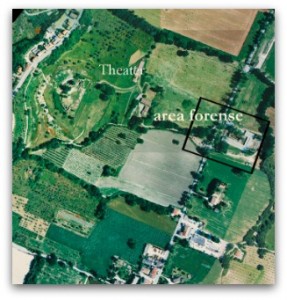 Urbisaglia (20mins)
Urbisaglia (20mins)
Only 5 minutes drive from Abbadia di Fiastra and is home to the impressive Roman site of Urbisaglia which provides tours of its frescoed forum, theatre and amphitheatre, the roman water cistern, medieval castle and museum with Roman artefacts from the area. There is also a good ristorante Le Logge for Lunch.
Loreto (45mins)
The striking hill town of Loreto lies just inland from the Adriatic Sea and is one of the world’s most important shrines to the Virgin Mary. The town is host to thousands of pilgrims who travel here from around the world.
The great dome of the Sanctuario della Santa Casa dominates the countryside for miles around; under the roof stands the rustic cottage from Nazareth that witnessed the Annunciation and the childhood of Jesus (see the tradition of the Holy House below).
Although the Holy House arrived, according to legend in 1294, but it was not until 1507 that the Church finally approved of Loreto as a place of pilgrimage, though work on the church had begun in 1468. The Sanctuary is a showcase of work by many of the most celebrated names of late Renaissance Italy and gives even the unbeliever good reason to come here..
The Museo-Pinacoteca inside preserves a fine group of late works by Lorenzo Lotto (the Venetian master retired and died in the monastery here in 1556) and an unusual collection of Renaissance ceramic pharmacist’s jars. Hidden away in a corner are also some 70 carved blocks of box-wood used until the 1940’s to stamp designs on pilgrims bodies which were then indelibly tattooed as permanent souvenirs of their pilgrimage to Loreto.
Cingoli (20mins)
A fantastic town that towers over the surrounding countryside and is referred to as “Balcony of Le Marche” Climb up Corso Garibaldi to Piazza Vittorio Emanuele, was built on the site of the forum of Roman Cingulum and is still the heart of this lovely town. To one side stands a fine 16thC Renaissance town hall with a much earlier clock tower. Inside is the Museo Archeologico to see the collection call at the library (Biblioteca comunale) in Via Mazzini 1. The library also houses the town’s Pinacoteca, or art gallery, with another of the region’s serendipity collections of paintings by Lorenzo Lotto. Cingoli has its ownm sizeable lake with beaches and pleasureboats, below the dam is an adventure park with zip wires, tightropes and climbing walls.
Ascoli Piceno (1.5hrs)
The city of Ascoli Piceno is dominated by numerous medieval towers and the Piazza del Popolo which is tiled with travertine and undoubtedly one of the most elegant squares of Italy. An amazing array of gothic architecture, great riverside walks, shopping and art galleries, plus some wonderful bars to sample the local Piceni wines. Oh, make sure you do some people watching in the Art Nouveaux Bar Meletti in the main Piazza.
Caldarola (25 mins)
Caldarola dominated by well preserved Pallotta castle, where building started in the 9th Century and which was transformed in the 16th by the Pallotta family, who still own the castle and now open it to the public, there are also 3 other castles in the surrounding Marche countryside.
Camerino (35mins)
The panoramic university hill town of Camerino has a history that goes back to Neolithic times. It has remained unchanged since its Renaissance heyday, when the local Da Varanno family governed much of surrounding Le Marche. Imposing churches, palaces and art plus lovely gardens, museums, outdoor cafes and some great shops.
Amandola (60 mins)
This touring centre for the Sibillini national park has a wonderful gothic piazza, sit in one of Amandola’s bars there and watch the world go by, or try getting up and sampling the museum of rural history.
Tolentino (20 mins)
Tolentino is a vibrant medieval city home to the shrine of St Nicola, and some amazing architecture including an ancient roman bridge and a bizarre clock tower in the main square and the nearby 12th century Castello della Rancia. Wander round the museum of caricature and humour in art, or simply enjoy the shopping, cafes and trattorie.
 Recanati (25 mins)
Recanati (25 mins)
Recanati is a sophisticated town and comune in the Province of Macerata, Marche region of Italy. Recanati was founded around 1150 AD from three pre-existing castles. In 1290 it proclaimed itself an independent republic and, in the 15th century, was famous for its international fair. In the March 1798 it was conquered by Napoleon Bonaparte.
It is the hometown of tenor Beniamino Gigli and poet Giacomo Leopardi, which is why the town is known to some as “the city of poetry”. It contains the Teatro Persiani named after the composer of operas in the first part of the 19th Century, Giuseppe Persiani, who was born in the town in 1799. The town commands an elevated position above rolling hills to the West and the adriatic coast to the West, in Summer a superb Opera season is hosted at the Villa Corrado Mels home to a number of important Lotto paintings.
Osimo (40 mins)
A few kilometres from Recanati stands Osimo with its honey coloured centro storico on the hill above the more modern town below. Most of its best buildings date from the 16th and 17th centuries but evidence of a more distant past sometimes show through. For this place was once the Roman town of Auximum. Take time to wander its inviting streets.
The entrance hall of the fine 17C Palazzo Comunale, or town hall, in main Piazza del Comune are a dozen headless statues from Roman times; they once stood in the town’s forum and were, according to tradition, decapitated during an early occupation of the place.
Also hunt out the sturdy blocks that remain of the Roman walls above Via Fonte Magna and notice that the street plan of the old town still retains its Roman layout. The 13C Duomo, with its amazing crypt, still retains its mosaic pavement from medieval times; the church, originally built in the 13th century in romanesque-gothic style.
The old romanesque church of San Francesco has been fully restored and is a sanctuary dedicated to San Giuseppe da Copertino (1603-1663) and an important centre of pilgrimage.
San Giuseppe is known as the patron saint of those undergoing exams and thanks also to his celebrated capacity for levitation, as a patron saint of pilots. His remains are kept in a crystal urn in the modern crypt.
In the heart of the old centre look out for Palazzo Gallo, a splendid palace from the 16th century with an epic fresco of the Judgement of Solomon (1609) by the Tuscan painter Pomarancio.
A few kilometres south-east of Osimo in the valley of the Musone river, stands the imposing Sanctuary of Campocavallo, a striking piece of early 20th century architecture in Lombard neo-gothic style. It guards a venerated image of the Virgin behind the main altar; in 1892 it was seen to weep by the faithful, a phenomenon reputedly repeated a number of times since then.
San Severino (20 mins)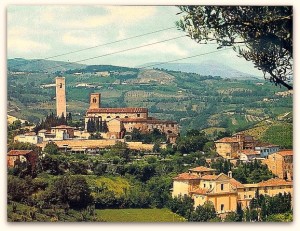
Founded around 550 AD after the Goths had destroyed the Roman Septembeda further down the hill, this enchanting town has a great mix of medieval and Renaissance buildings.
Its outstanding feature is its unusual elliptical main square, Piazza del Popolo, encircled by shady arcades (see above) and towered over by the castle and church on the hill.
Before taking your aperitivo here, search out the Pinacoteca in Via Salimbeni 39, to see Pinturicchio’s sumptious Madonna della Pace and earthy pictures by the local Salimbeni brothers. You can see more of their endearing work in the nearby romanesque church of San Lorenzo in Doliolo.
The town is home to a vibrant Saturday morning market and the San Severino blues Festival that stages Blues, acoustic and indie, rock gigs throughout San Severino and the neighbouring countryside in June / July each year.
Matellica & Frasassi (45 mins)
The centre for one of the Verdicchio wines from the Marche region, Matellica is a lovely and interesting town that is also home to the Armani fashion outlet, where you can buy this famous style icons clothing direct. Matellica is half n-route to Frasassi ; which has an incredible network of underground limestone caves that is the largest in Europe and a must see for any visitor. Tours every hour in most languages.
Agriturismo Fontechiara is located in Treia in the province of Macerata in the region of Le Marche in central Italy. We offer B&B or bed and breakfast holidays or for lovers of slow food there is a half board option. A vacation at Fontechiara allows you to sample ecotourism, locally grown food, our own organic produce, home cooking and great Le Marche wines in a restored farmhouse with stylishly furnished rooms and excellent facilities including a swimming pool. There is the possibility of horse riding, fishing and courses about olive oil. We are ideally located for sports and outlet shopping. Le Marche has fantastic beaches, mountains, nature, history, art, activities and more. Please check out our reasonable prices or contact us for more information or to book.
Le città delle Marche offrono scenari molto diversi e tutti affascinanti. Molti borghi medievali fortificati dalle antiche mura sono ben conservati e spesso racchiudono luoghi di ritrovamenti archeologici di resti romani come Urbisaglia e Falerone. Ad Osimo e Loreto si può ammirare l’architettura rinascimentale e Porto S.Giorgio e Civitanova Marche affascinano con le ville in stile Liberty e art nouveaux.
La regione Marche è anche terra di teatri e oltre a tanti piccoli teatri antichi meravigliosamente decorati, vanta la presenza dello Sferisterio di Macerata, una delle più importanti arene d’Italia, dove ogni anno si svolge il Macerata opera festival.
L’agriturismo Fontechiara si trova a mezza via tra i monti Sibillini e il Parco nazionale del Monte Conero, si raggiungono con grande facilità sia la riserva naturale dell’abbazia di Fiastra che il parco delle Grotte di Frasassi, e siamo letteralmente circondati da città e borghi medievali tutti da visitare e ammirare.
Di seguito elenchiamo alcune di queste città e le relative attrattive.
Macerata (20 min )
Macerata è ben conosciuta nel mondo dell’opera lirica per l’annuale open-air opera festival che si svolge da luglio ad agosto nella famosa Arena Sferisterio, che offre posto a 7000 persone.
L’arena è stata costruita in stile neoclassico nel 1820, utilizzando fondi privati e l’acustica al suo interno è decantata dagli appassionati di musica. Nulla da invidiare alla più pubblicizzata Arena di Verona.
Il centro di Macerata si trova in cima alla collina ed è stato costruito quasi interamente tra il 16esimo e il 19esimo secolo. Una delle opere architettoniche più impressionante della città è la Loggia dei Mercanti con i suoi portici a due livelli di archi, situata nella centrale Piazza della Libertà.
Dalla Piazza della Libertà si può percorrere Corso Matteotti con i suoi magnifici palazzi mentre Corso della Repubblica arriva in Piazza Vittorio Veneto, dove si trovano la galleria d’arte cittadina e il museo. Qui si possono ammirare molte opere di artisti marchigiani ed umbri come il famoso dipinto “Madonna con bambino” di Carlo Crivelli. Nello stesso palazzo si trovano anche il museo delle carrozze ed il museo dedicato all’unificazione dell’Italia e alla resistenza durante la guerra.
A nord della città, lungo il fiume Potenza, alla congiunzione con la SS571, si trova l’antica Helvia Recina, ed è possibile visitare i resti dell’antica città romana e il grande anfiteatro.
Abbadia di Fiastra (20 min )
Il monastero cistercense di Fiastra è stato fondato nel 1142. Il materiale di costruzione fu fornito dalla vicina città romana Urbs Salvia, e il suo territorio all’epoca si espandeva per 30 km verso la costa. Ancora oggi il terreno e le vigne circostanti vengono coltivati dai monaci ed il vino e altri prodotti sono acquistabili presso l’abbadia.
Il parco dell’Abbadia di Fiastra comprende oltre il monastero medievale anche un museo archeologico e una bellissima riserva naturale aperta al pubblico.
 Jesi (40 min )
Jesi (40 min )
Jesi è una delle città più importanti del centro Italia e il suo centro storico è animato da una vivacità culturale inaspettata che ha fatto guadagnare alla città il sopranome “ La Milano delle Marche “.
La caratteristica architettonica più appariscente è un lunghissimo tratto di massicce mura antiche risalenti al 14esimo secolo, costruite su fondamenta romane e fortificate da contrafforti e torri imprendibili.
Le stradine del centro storico percorrono una stretta cresta e sono gremite di negozietti e bar che offrono molte tentazioni ai visitatori.
Nella parte nord-orientale della città si trova Piazza Federico II, dove un tempo sorgeva il foro romano dell’antica Aesis. Vi si trova adesso il Duomo del 18esimo secolo.
Percorrendo per un breve tratto Via Pergolesi si raggiunge Piazza Colocci, dove si può ammirare uno dei palazzi più belli della città, Palazzo della Signoria. Questo edificio rinascimentale è stato costruito alla fine del 15esimo secolo da Francesco di Giorgio Martini, il genio senese ben conosciuto per le sue costruzioni militari.
Il grande leone rampante sopra l’ingresso rappresentava il potere della città. All’interno troviamo un cortile con colonnato a tre ordini, con le colonne del primo livello in mattoni, quelle del secondo livello in marmo e quelle del terzo livello in legno.
Continuando Via Pergolesi, si raggiunge Piazza della Repubblica, la più grande piazza della città con il suo teatro del 18esimo secolo:Teatro Pergolesi, dove ogni autunno si svolge una prestigiosa stagione di opere liriche.
La strada principale ossia Corso Matteotti percorre le vecchie fondamenta romane.
In Via XV Settembre si trova Palazzo Pianetti che ospita la pinacoteca comunale con una piccola collezione di opere di Lorenzo Lotto, da non perdere.
Urbisaglia (20 min )
A soli 5 minuti dall’Abbadia di Fiastra si trova il sito archeologico romano di Urbisaglia. E’ possibile assistere ad una visita guidata per vedere il meraviglioso foro affrescato, il teatro e l’anfiteatro, l’antica cisterna per l’acqua, il castello medievale e il museo con i manufatti di origine romana.
Loreto (45 min )
Sulle colline poco distanti dal mare adriatico si trova Loreto, uno dei santuari per la Vergine Maria più importanti del mondo che ogni anno ospita migliaia di pellegrini che arrivano da tutto il mondo.
Il duomo del Santuario della Santa Casa domina il paesaggio circostante ed è visibile anche da grandi distanze. Al suo interno si può ammirare la santa casa di Nazareth, che secondo la legenda arrivò a Loreto nel 1294. La chiesa dichiarò Loreto luogo di pellegrinaggio solo nel 1507 ed i lavori per la costruzione del duomo sono iniziati nel 1468. Il santuario è una vetrina dei nomi più importanti di artisti del tardo rinascimento italiano ed attira anche i non credenti.
Il museo della Pinacoteca conserva una serie di lavori di Lorenzo Lotto, il maestro veneziano che si ritirò e morì nel monastero nel 1556.
Il museo presenta inoltre una collezione rinascimentale di contenitori di ceramica per uso farmaceutico ed in un angolo nascosto ci sono ancora circa 70 blocchi di legno intagliati che venivano usati fino al 1940 per stampare dei disegni sul corpo dei pellegrini che in seguito vennero tatuati come testimonianza indelebile del loro pellegrinaggio a Loreto.
Il comune di Macerata organizza ogni anno un pellegrinaggio da Macerata a Loreto nel mese di giugno
Cingoli (20 min )
La bellissima cittadina di Cingoli si trova in cima ad un colle a 790 m di altitudine e questa posizione sopraelevata unita ad una ampia veduta panoramica gli ha conferito il titolo di “ Balcone delle Marche “.
Salendo Corso Garibaldi si arriva in Piazza Vittorio Emanuele, che è stata costruita sul sito del foro dell’antica Cingulum ed è ancora il cuore della città. Da una parte vi si trova il bel municipio rinascimentale del 16esimo secolo con una torre ad orologio molto più antica. Al suo interno c’è il museo archeologico. Per visitarlo bisogna rivolgersi alla Biblioteca comunale in Via Mazzini 1. La biblioteca è anche sede della Pinacoteca che contiene alcuni quadri di Lorenzo Lotto.
Vicino a Cingoli si trova un bellissimo lago, il lago di Castreccioni con spiagge e stabilimenti balneari dove noleggiare barche e pedalò ed un fantastico parco avventura con percorsi sospesi in altezza e pareti per le arrampicate e il free climbing per grandi e bambini.
Ascoli Piceno (1.5 h )
La città di Ascoli Piceno presenta un gran numero di torri medievali che dominano il centro storico e la famosa Piazza del Popolo, piastrellata in travertino è senza dubbio una delle più eleganti piazze d’Italia.
L’insieme di meravigliose costruzioni in stile gotico, percorsi incantevoli lungo il fiume, negozi, gallerie d’arte e numerosi bar dove gustare il vino rosso piceno, rendono questa città davvero godibile.
Non tralasciate una visita al Bar Meletti in stile Art Noveaux sulla piazza principale.
Caldarola (25 min )
Caldarola è famosa per il castello molto ben conservato, la cui costruzione iniziò nel nono secolo ed è tuttora proprietà della famiglia Pallotta che lo ha aperto al pubblico. Nei dintorni ci sono altri tre castelli da visitare.
Camerino (35 min )
La città universitaria situata tra le alte colline maceratesi ha una storia che riporta ai tempi del Neolitico. E’ rimasta inalterata fino a raggiungere il suo apice durante il rinascimento, quando la locale famiglia Da Varano governava su un ampio territorio marchigiano circostante.
Sono assolutamente da vedere le chiese, i palazzi, i musei ed i giardini della città.
Amandola (60 min )
Amandola costituisce il punto centrale per visitare il parco nazionale dei Monti Sibillini. Ha una bellissima piazza in stile gotico ed un museo sulla storia rurale.
Tolentino (20 min )
Tolentino è una vivace cittadina medievale e vi si trova il bellissimo Santuario di S. Nicola.
La sua architettura è straordinaria ed in particolare l’antico ponte romano, il campanile sul corso principale ed il Castello della Rancia del 12esimo secolo.
Sono da visitare anche il museo della caricatura e dell’arte umoristica.
Recanati (25 min )
Recanati è una delle città più importanti della provincia di Macerata e fu fondata nel 1150 a partire da tre castelli già esistenti. Nel 1290 la città si autoproclamò repubblica indipendente e nel 15esimo secolo era famosa per la sua fiera internazionale. Nel marzo del 1798 fu conquistata da Napoleone Bonaparte.
E’ il luogo di nascita del tenore Beniamino Gigli e del poeta Giacomo Leopardi e di conseguenza Recanati fu soprannominata “città della poesia “.
Si può visitare la casa natia del poeta ed il teatro Persiani, dedicato a Giuseppe Persiani, nato a Recanati nel 1799, compositore di opere durante la prima parte del 19esimo secolo.
La città si trova immersa tra le colline e la costa adriatica. Durante l’estate Villa Colloredo Mels ospita una favolosa stagione lirica ed espone diversi quadri importanti di Lotto.
Osimo (40 min )
A pochi chilometri da Recanati troviamo Osimo con il suo centro storico dai colori caldi sulla cima della collina e la parte più recente della città ai suoi piedi. I suoi palazzi più belli risalgono al 16esimo e 17esimo secolo ma qua e là ci sono scorci su un passato più remoto dell’antica Auximum dei tempi romani, che tuttora invita ad una bella passeggiata al centro.
Nella sala d’ingresso del Palazzo Comunale, situato nella medesima piazza si trovano una dozzina di statue romane decapitate che un tempo ornavano l’antico foro della città e vennero decapitate durante l’occupazione della città.
In Via Fonte Magna si possono vedere i resti degli enormi blocchi di pietra che costituivano le mura romane. L’attuale piantina della città conserva il disegno dell’antica città romana.
Il duomo del 13esimo secolo in stile gotico – romano presenta una cripta davvero straordinaria e conserva un pavimento a mosaico del medioevo.
La chiesa romana di S. Francesco è stata completamente restaurata ed il santuario è dedicato a S. Giuseppe da Copertino (1603- 1663 ) ed è un importante meta di pellegrinaggio.
S. Giuseppe è il santo patrono di chi deve affrontare un esame e grazie alla sua capacità di levitazione, anche dei piloti. I suoi resti sono conservati in un’urna di cristallo nella cripta.
Nel cuore del centro si trova lo splendido Palazzo Gallo del 16esimo secolo con l’epico affresco del pittore toscano Pomarancio, “Il giudizio di Salomone “(1609).
A pochi chilometri a sud- est di Osimo nella valle del fiume Musone, c’è l’imponente santuario di Campocavallo, uno spettacolare pezzo di architettura del 20esimo secolo in stile neo – gotico.
Dietro l’altare si trova una venerata immagine della santa vergine che nel 1892 fu vista piangere dai fedeli e da allora pare che il fenomeno si sia ripetuto diverse altre volte.
S.Severino ( 20 min )
Fu fondata nel 550 dopo che l’antica Septempeda romana era stata distrutta dai goti.
L’incantevole cittadina mostra una grande varietà di costruzioni medievali e rinascimentali.
La sua particolarità più rara è la piazza centrale di forma elittica. La suddetta Piazza del Popolo è circondata da arcate che invitano a godersi un bel caffè all’ombra in uno dei numerosi bar della piazza, torreggiata dal castello e dalla chiesa sulla collina retrostante la città.
Comunque prima dell’aperitivo bisogna visitare la pinacoteca in Via Salimbeni 39 per ammirare la Madonna della Pace del Pinturicchio e diversi quadri dei fratelli Salimbeni.
Altri loro lavori sono visibili nella vicina chiesa romana di San Lorenzo in Doliolo.
Ogni Sabato si può passeggiare tra le bancarelle del mercato settimanale e a giugno/luglio si tiene il favoloso San Severino Blues Festival che ogni anno ospita artisti famosi nel mondo.
Matelica & Frasassi (45 min )
Matelica è uno dei centri più famosi del vino Verdicchio della regione Marche ed è una bella cittadina, interessante sotto molti aspetti. L’Armani Fashion Outlet è meta di molti appassionati dell’alta moda a prezzi convenienti. Inoltre siamo nelle vicinanze delle Grotte di Frasassi con il complesso ipogeo sotterraneo più grande d’Europa, da non perdere assolutamente. Ci sono visite guidate in molte lingue ad intervalli di un’ora circa.
“L’Agriturismo Fontechiara si trova nelle Marche, in provincia di Macerata a 4 km da Treia.
Si può scegliere una vacanza Bed and Breakfast – B&B, ma agli amanti dello slow food e della cucina genuina proponiamo vacanze in mezza pensione.
Un soggiorno a Fontechiara permette di seguire lo spirito dell’ ecoturismo e dà l’opportunità di assaggiare in un ambiente incantevole, i nostri prodotti biologici e regionali, come l’olio d’oliva extravergine Fontechiara ed i rinomati vini marchigiani.
Il casale coniuga armoniosamente il fascino antico con le moderne comodità ed ha una piscina circondata dal verde.
Offriamo vacanze dedicate alla tranquillità, all’arte, alla pesca o all’acquisizione di conoscenze sulla produzione e la valutazione dell’olio d’oliva extravergine; i dintorni sono perfetti per una vacanza sportiva in sella ad una mountain bike o per fare una gita di shopping in uno dei tanti outlet della regione.
Accogliamo con piacere anche i nostri amici a quattro zampe.
Nelle Marche si trovano spiagge incantevoli, montagne mozzafiato, boschi preziosi, natura incontaminata e innumerevoli luoghi di interesse storico e artistico oltre agli infiniti piaceri enogastronomici.
E’ veramente “L’Italia in una regione”.
Consultate i nostri prezzi e le offerte speciali per una vacanza indimenticabile.”
Le Marche tours & sightseeing
Le Marche in Central Italy and its superb scenery is home to many well preserved fortified hill towns which include Roman ruins at nearby Urbisaglia and Falerone, renaissance architecture at Loreto and Osimo and ‘Liberty’ style art nouveaux villas at Porto San Giorgio and Civitanova Marche.
A number of National Parks that include the Sibillini, Abbadia di Fiasr=tra Nature reserve and Conero National Park with easy reach of our Le Marche Farmhouse
Le Marche is also the land of many ornate theatres including the grand ‘Sferisterio’ amphitheatre in Macerata, which holds 7,000 one of the main fixtures on Italy’s summer open-air opera. Le Marche also has some of central Italy’s finest architectural monuments. The following is a list of beautiful and important towns within a short
Macerata (20mins)
Macerata is well known across the opera world for its annual open-air opera festival in July and takes place in the 7,000-seater Sferisterio – a very impressive neo-classical arena that was built with private funds in the 1820’s. It was originally built as a soccer stadium rather than a Puccini aria.
The centre of Macerata is quite up market and was almost entirely built between the 16th and 19th centuries. The Renaissance two-tiered arcades of the Loggia dei Mercanti on central Piazza della Liberta’ is the town’s most striking piece of architecture.
The best of the the Macerata palaces line Corso Matteotti, the road that leaves the Piazza at the side of the Loggia, while Corso della Repubblica will take you to Piazza Vittorio Veneto and the town gallery and museum. Home to many Umbrian and Marchigiani artists – most important is Carlo Crivelli’s Madonna and Child. In the same building are the fine carriages in the Museo delle Carrozze and a museum dedicated to the Unification of Italy and wartime resistance.
Just north of the town, by the river at Villa Potenza, lies ancient Helvia Ricina, the remnants of the old Roman city can still be seen, including the large amphitheatre, which stands just by the junction with the SS571, as well as a stretch of stone-paved roadway.
Abbadia di Fiastra (20mins)
The Cistercian monastery of Fiastra was founded in 1142, the building material was taken from the near Roman city ‘Urbs Salvia’ whose farmland stretched 30km to the coast in medieval times. Today the surrounding parkland is still cultivated by the monks and wines and other produce is on sale to the public, there are two very good well priced restaurants, and the medieval monastery, an archeological museum and beautiful nature reserve are open to the public.
Jesi (40 mins)
This thriving and elegant centre is one of the most interesting towns in central Le Marche, has a sophisticated old centre and lively cultural life that has earned it the nickname “Milano of the Marche”.
Jesi’s most striking feature greets you as you arrive – is an enormous stretch of massive 14thC fortified walls (above), built on Roman foundations, these are reinforced with buttresses and impregnable towers, and topped by houses. The main streets of the walled historic centre run along a narrow ridge and provide many temptations to the Le Marche visitor.
In Piazza Federico II in the north-eastern corner of the town where the Roman forum of Aesis once lay.In the Piazza stands the 18thC Duomo, a few steps down Via Pergolesi and you will be in Piazza Colocci and in front of Jesi’s most handsome building, Palazzo della Signoria (below). This Renaissance palace was built at the end of the 15thC by Francesco di Giorgio Martini, the Sienese genius best known for his military architecture. The large rampant lion above the entrance is the symbol of the power the city once held. Inside there is an impressive three-tiered courtyard with brick columns on the first level, marble on the second and wooden on the third.
Continue along Via Pergolesi to Piazza della Repubblica; Jesi’s largest square is dominated by the town’s 18thC theatre, Teatro Pergolesi, home to a prestigous autumn opera season.The main road Corso Matteotti runs straight along Roman foundations. On Via XV Settembre stands Jesi’s most stylish building, Palazzo Pianetti, the ornate interior is home to the civic art gallery (Pinacoteca Comunale) with a small collection of Lorenzo Lotto’s finest works – The Judgement of Santa Lucia, a Visitation, an Annunciation and a restless Deposition.
Urbisaglia (20mins)
Only 5 minutes drive from Abbadia di Fiastra and is home to the impressive Roman site of Urbisaglia which provides tours of its frescoed forum, theatre and amphitheatre, the roman water cistern, medieval castle and museum with Roman artefacts from the area. There is also a good ristorante Le Logge for Lunch.
Loreto (45 mins)
The striking hill town of Loreto lies just inland from the Adriatic Sea and is one of the world’s most important shrines to the Virgin Mary. The town is host to thousands of pilgrims who travel here from around the world.
The great dome of the Sanctuario della Santa Casa dominates the countryside for miles around; under the roof stands the rustic cottage from Nazareth that witnessed the Annunciation and the childhood of Jesus (see the tradition of the Holy House below).
Although the Holy House arrived, according to legend in 1294, but it was not until 1507 that the Church finally approved of Loreto as a place of pilgrimage, though work on the church had begun in 1468. The Sanctuary is a showcase of work by many of the most celebrated names of late Renaissance Italy and gives even the unbeliever good reason to come here..
The Museo-Pinacoteca inside preserves a fine group of late works by Lorenzo Lotto (the Venetian master retired and died in the monastery here in 1556) and an unusual collection of Renaissance ceramic pharmacist’s jars. Hidden away in a corner are also some 70 carved blocks of box-wood used until the 1940’s to stamp designs on pilgrims bodies which were then indelibly tattooed as permanent souvenirs of their pilgrimage to Loreto.
Cingoli (20 mins)
A fantastic town that towers over the surrounding countryside and is referred to as “Balcony of Le Marche” Climb up Corso Garibaldi to Piazza Vittorio Emanuele, was built on the site of the forum of Roman Cingulum and is still the heart of this lovely town. To one side stands a fine 16thC Renaissance town hall with a much earlier clock tower. Inside is the Museo Archeologico to see the collection call at the library (Biblioteca comunale) in Via Mazzini 1. The library also houses the town’s Pinacoteca, or art gallery, with another of the region’s serendipity collections of paintings by Lorenzo Lotto. Cingoli has its ownm sizeable lake with beaches and pleasureboats, below the dam is an adventure park with zip wires, tightropes and climbing walls.
Ascoli Piceno (1.5hrs)
The city of Ascoli Piceno is dominated by numerous medieval towers and the Piazza del Popolo which is tiled with travertine and undoubtedly one of the most elegant squares of Italy. An amazing array of gothic architecture, great riverside walks, shopping and art galleries, plus some wonderful bars to sample the local Piceni wines. Oh, make sure you do some people watching in the Art Nouveaux Bar Meletti in the main Piazza.
Caldarola (25 mins)
Caldarola dominated by well preserved Pallotta castle, where building started in the 9th Century and which was transformed in the 16th by the Pallotta family, who still own the castle and now open it to the public, there are also 3 other castles in the surrounding Marche countryside.
Camerino (35mins)
The panoramic university hill town of Camerino has a history that goes back to Neolithic times. It has remained unchanged since its Renaissance heyday, when the local Da Varanno family governed much of surrounding Le Marche. Imposing churches, palaces and art plus lovely gardens, museums, outdoor cafes and some great shops.
Amandola (60 mins)
This touring centre for the Sibillini national park has a wonderful gothic piazza, sit in one of Amandola’s bars there and watch the world go by, or try getting up and sampling the museum of rural history.
Tolentino (20mins)
Tolentino is a vibrant medieval city home to the shrine of St Nicola, and some amazing architecture including an ancient roman bridge and a bizarre clock tower in the main square and the nearby 12th century Castello della Rancia. Wander round the museum of caricature and humour in art, or simply enjoy the shopping, cafes and trattorie.
Recanati (25 mins)
Recanati is a sophisticated town and comune in the Province of Macerata, Marche region of Italy. Recanati was founded around 1150 AD from three pre-existing castles. In 1290 it proclaimed itself an independent republic and, in the 15th century, was famous for its international fair. In the March 1798 it was conquered by Napoleon Bonaparte.
It is the hometown of tenor Beniamino Gigli and poet Giacomo Leopardi, which is why the town is known to some as “the city of poetry”. It contains the Teatro Persiani named after the composer of operas in the first part of the 19th Century, Giuseppe Persiani, who was born in the town in 1799. The town commands an elevated position above rolling hills to the West and the adriatic coast to the West, in Summer a superb Opera season is hosted at the Villa Corrado Mels home to a number of important Lotto paintings.
Osimo (40 mins)
A few kilometres from Recanati stands Osimo with its honey coloured centro storico on the hill above the more modern town below. Most of its best buildings date from the 16th and 17th centuries but evidence of a more distant past sometimes show through. For this place was once the Roman town of Auximum. Take time to wander its inviting streets.
The entrance hall of the fine 17C Palazzo Comunale, or town hall, in main Piazza del Comune are a dozen headless statues from Roman times; they once stood in the town’s forum and were, according to tradition, decapitated during an early occupation of the place.
Also hunt out the sturdy blocks that remain of the Roman walls above Via Fonte Magna and notice that the street plan of the old town still retains its Roman layout. The 13C Duomo, with its amazing crypt, still retains its mosaic pavement from medieval times; the church, originally built in the 13th century in romanesque-gothic style.
The old romanesque church of San Francesco has been fully restored and is a sanctuary dedicated to San Giuseppe da Copertino (1603-1663) and an important centre of pilgrimage.
San Giuseppe is known as the patron saint of those undergoing exams and thanks also to his celebrated capacity for levitation, as a patron saint of pilots. His remains are kept in a crystal urn in the modern crypt.
In the heart of the old centre look out for Palazzo Gallo, a splendid palace from the 16th century with an epic fresco of the Judgement of Solomon (1609) by the Tuscan painter Pomarancio.
A few kilometres south-east of Osimo in the valley of the Musone river, stands the imposing Sanctuary of Campocavallo, a striking piece of early 20th century architecture in Lombard neo-gothic style. It guards a venerated image of the Virgin behind the main altar; in 1892 it was seen to weep by the faithful, a phenomenon reputedly repeated a number of times since then.
San Severino (20 minutes)
Founded around 550 AD after the Goths had destroyed the Roman Septembeda further down the hill, this enchanting town has a great mix of medieval and Renaissance buildings.
Its outstanding feature is its unusual elliptical main square, Piazza del Popolo, encircled by shady arcades (see above) and towered over by the castle and church on the hill.
Before taking your aperitivo here, search out the Pinacoteca in Via Salimbeni 39, to see Pinturicchio’s sumptious Madonna della Pace and earthy pictures by the local Salimbeni brothers. You can see more of their endearing work in the nearby romanesque church of San Lorenzo in Doliolo.
The town is home to a vibrant Saturday morning market and the San Severino blues Festival that stages Blues, acoustic and indie, rock gigs throughout San Severino and the neighbouring countryside in June / July each year.
Matellica & Frasassi (45 mins)
The centre for one of the Verdicchio wines from the Marche region, Matellica is a lovely and interesting town that is also home to the Armani fashion outlet, where you can buy this famous style icons clothing direct. Matellica is half n-route to Frasassi ; which has an incredible network of underground limestone caves that is the largest in Europe and a must see for any visitor. Tours every hour in most languages
Le Marche tours & sightseeing
Le Marche in Central Italy and its superb scenery is home to many well preserved fortified hill towns which include Roman ruins at nearby Urbisaglia and Falerone, renaissance architecture at Loreto and Osimo and ‘Liberty’ style art nouveaux villas at Porto San Giorgio and Civitanova Marche.
A number of National Parks that include the Sibillini, Abbadia di Fiasr=tra Nature reserve and Conero National Park with easy reach of our Le Marche Farmhouse
Le Marche is also the land of many ornate theatres including the grand ‘Sferisterio’ amphitheatre in Macerata, which holds 7,000 one of the main fixtures on Italy’s summer open-air opera. Le Marche also has some of central Italy’s finest architectural monuments. The following is a list of beautiful and important towns within a short
Macerata (20mins)
Macerata is well known across the opera world for its annual open-air opera festival in July and takes place in the 7,000-seater Sferisterio – a very impressive neo-classical arena that was built with private funds in the 1820’s. It was originally built as a soccer stadium rather than a Puccini aria.
The centre of Macerata is quite up market and was almost entirely built between the 16th and 19th centuries. The Renaissance two-tiered arcades of the Loggia dei Mercanti on central Piazza della Liberta’ is the town’s most striking piece of architecture.
The best of the the Macerata palaces line Corso Matteotti, the road that leaves the Piazza at the side of the Loggia, while Corso della Repubblica will take you to Piazza Vittorio Veneto and the town gallery and museum. Home to many Umbrian and Marchigiani artists – most important is Carlo Crivelli’s Madonna and Child. In the same building are the fine carriages in the Museo delle Carrozze and a museum dedicated to the Unification of Italy and wartime resistance.
Just north of the town, by the river at Villa Potenza, lies ancient Helvia Ricina, the remnants of the old Roman city can still be seen, including the large amphitheatre, which stands just by the junction with the SS571, as well as a stretch of stone-paved roadway.
Abbadia di Fiastra (20mins)
The Cistercian monastery of Fiastra was founded in 1142, the building material was taken from the near Roman city ‘Urbs Salvia’ whose farmland stretched 30km to the coast in medieval times. Today the surrounding parkland is still cultivated by the monks and wines and other produce is on sale to the public, there are two very good well priced restaurants, and the medieval monastery, an archeological museum and beautiful nature reserve are open to the public.
Jesi (40 mins)
This thriving and elegant centre is one of the most interesting towns in central Le Marche, has a sophisticated old centre and lively cultural life that has earned it the nickname “Milano of the Marche”.
Jesi’s most striking feature greets you as you arrive – is an enormous stretch of massive 14thC fortified walls (above), built on Roman foundations, these are reinforced with buttresses and impregnable towers, and topped by houses. The main streets of the walled historic centre run along a narrow ridge and provide many temptations to the Le Marche visitor.
In Piazza Federico II in the north-eastern corner of the town where the Roman forum of Aesis once lay.In the Piazza stands the 18thC Duomo, a few steps down Via Pergolesi and you will be in Piazza Colocci and in front of Jesi’s most handsome building, Palazzo della Signoria (below). This Renaissance palace was built at the end of the 15thC by Francesco di Giorgio Martini, the Sienese genius best known for his military architecture. The large rampant lion above the entrance is the symbol of the power the city once held. Inside there is an impressive three-tiered courtyard with brick columns on the first level, marble on the second and wooden on the third.
Continue along Via Pergolesi to Piazza della Repubblica; Jesi’s largest square is dominated by the town’s 18thC theatre, Teatro Pergolesi, home to a prestigous autumn opera season.The main road Corso Matteotti runs straight along Roman foundations. On Via XV Settembre stands Jesi’s most stylish building, Palazzo Pianetti, the ornate interior is home to the civic art gallery (Pinacoteca Comunale) with a small collection of Lorenzo Lotto’s finest works – The Judgement of Santa Lucia, a Visitation, an Annunciation and a restless Deposition.
Urbisaglia (20mins)
Only 5 minutes drive from Abbadia di Fiastra and is home to the impressive Roman site of Urbisaglia which provides tours of its frescoed forum, theatre and amphitheatre, the roman water cistern, medieval castle and museum with Roman artefacts from the area. There is also a good ristorante Le Logge for Lunch.
Loreto (45 mins)
The striking hill town of Loreto lies just inland from the Adriatic Sea and is one of the world’s most important shrines to the Virgin Mary. The town is host to thousands of pilgrims who travel here from around the world.
The great dome of the Sanctuario della Santa Casa dominates the countryside for miles around; under the roof stands the rustic cottage from Nazareth that witnessed the Annunciation and the childhood of Jesus (see the tradition of the Holy House below).
Although the Holy House arrived, according to legend in 1294, but it was not until 1507 that the Church finally approved of Loreto as a place of pilgrimage, though work on the church had begun in 1468. The Sanctuary is a showcase of work by many of the most celebrated names of late Renaissance Italy and gives even the unbeliever good reason to come here..
The Museo-Pinacoteca inside preserves a fine group of late works by Lorenzo Lotto (the Venetian master retired and died in the monastery here in 1556) and an unusual collection of Renaissance ceramic pharmacist’s jars. Hidden away in a corner are also some 70 carved blocks of box-wood used until the 1940’s to stamp designs on pilgrims bodies which were then indelibly tattooed as permanent souvenirs of their pilgrimage to Loreto.
Cingoli (20 mins)
A fantastic town that towers over the surrounding countryside and is referred to as “Balcony of Le Marche” Climb up Corso Garibaldi to Piazza Vittorio Emanuele, was built on the site of the forum of Roman Cingulum and is still the heart of this lovely town. To one side stands a fine 16thC Renaissance town hall with a much earlier clock tower. Inside is the Museo Archeologico to see the collection call at the library (Biblioteca comunale) in Via Mazzini 1. The library also houses the town’s Pinacoteca, or art gallery, with another of the region’s serendipity collections of paintings by Lorenzo Lotto. Cingoli has its ownm sizeable lake with beaches and pleasureboats, below the dam is an adventure park with zip wires, tightropes and climbing walls.
Ascoli Piceno (1.5hrs)
The city of Ascoli Piceno is dominated by numerous medieval towers and the Piazza del Popolo which is tiled with travertine and undoubtedly one of the most elegant squares of Italy. An amazing array of gothic architecture, great riverside walks, shopping and art galleries, plus some wonderful bars to sample the local Piceni wines. Oh, make sure you do some people watching in the Art Nouveaux Bar Meletti in the main Piazza.
Caldarola (25 mins)
Caldarola dominated by well preserved Pallotta castle, where building started in the 9th Century and which was transformed in the 16th by the Pallotta family, who still own the castle and now open it to the public, there are also 3 other castles in the surrounding Marche countryside.
Camerino (35mins)
The panoramic university hill town of Camerino has a history that goes back to Neolithic times. It has remained unchanged since its Renaissance heyday, when the local Da Varanno family governed much of surrounding Le Marche. Imposing churches, palaces and art plus lovely gardens, museums, outdoor cafes and some great shops.
Amandola (60 mins)
This touring centre for the Sibillini national park has a wonderful gothic piazza, sit in one of Amandola’s bars there and watch the world go by, or try getting up and sampling the museum of rural history.
Tolentino (20mins)
Tolentino is a vibrant medieval city home to the shrine of St Nicola, and some amazing architecture including an ancient roman bridge and a bizarre clock tower in the main square and the nearby 12th century Castello della Rancia. Wander round the museum of caricature and humour in art, or simply enjoy the shopping, cafes and trattorie.
Recanati (25 mins)
Recanati is a sophisticated town and comune in the Province of Macerata, Marche region of Italy. Recanati was founded around 1150 AD from three pre-existing castles. In 1290 it proclaimed itself an independent republic and, in the 15th century, was famous for its international fair. In the March 1798 it was conquered by Napoleon Bonaparte.
It is the hometown of tenor Beniamino Gigli and poet Giacomo Leopardi, which is why the town is known to some as “the city of poetry”. It contains the Teatro Persiani named after the composer of operas in the first part of the 19th Century, Giuseppe Persiani, who was born in the town in 1799. The town commands an elevated position above rolling hills to the West and the adriatic coast to the West, in Summer a superb Opera season is hosted at the Villa Corrado Mels home to a number of important Lotto paintings.
Osimo (40 mins)
A few kilometres from Recanati stands Osimo with its honey coloured centro storico on the hill above the more modern town below. Most of its best buildings date from the 16th and 17th centuries but evidence of a more distant past sometimes show through. For this place was once the Roman town of Auximum. Take time to wander its inviting streets.
The entrance hall of the fine 17C Palazzo Comunale, or town hall, in main Piazza del Comune are a dozen headless statues from Roman times; they once stood in the town’s forum and were, according to tradition, decapitated during an early occupation of the place.
Also hunt out the sturdy blocks that remain of the Roman walls above Via Fonte Magna and notice that the street plan of the old town still retains its Roman layout. The 13C Duomo, with its amazing crypt, still retains its mosaic pavement from medieval times; the church, originally built in the 13th century in romanesque-gothic style.
The old romanesque church of San Francesco has been fully restored and is a sanctuary dedicated to San Giuseppe da Copertino (1603-1663) and an important centre of pilgrimage.
San Giuseppe is known as the patron saint of those undergoing exams and thanks also to his celebrated capacity for levitation, as a patron saint of pilots. His remains are kept in a crystal urn in the modern crypt.
In the heart of the old centre look out for Palazzo Gallo, a splendid palace from the 16th century with an epic fresco of the Judgement of Solomon (1609) by the Tuscan painter Pomarancio.
A few kilometres south-east of Osimo in the valley of the Musone river, stands the imposing Sanctuary of Campocavallo, a striking piece of early 20th century architecture in Lombard neo-gothic style. It guards a venerated image of the Virgin behind the main altar; in 1892 it was seen to weep by the faithful, a phenomenon reputedly repeated a number of times since then.
San Severino (20 mins)
Founded around 550 AD after the Goths had destroyed the Roman Septembeda further down the hill, this enchanting town has a great mix of medieval and Renaissance buildings.
Its outstanding feature is its unusual elliptical main square, Piazza del Popolo, encircled by shady arcades (see above) and towered over by the castle and church on the hill.
Before taking your aperitivo here, search out the Pinacoteca in Via Salimbeni 39, to see Pinturicchio’s sumptious Madonna della Pace and earthy pictures by the local Salimbeni brothers. You can see more of their endearing work in the nearby romanesque church of San Lorenzo in Doliolo.
The town is home to a vibrant Saturday morning market and the San Severino blues Festival that stages Blues, acoustic and indie, rock gigs throughout San Severino and the neighbouring countryside in June / July each year.
Matellica & Frasassi (45 mins)
The centre for one of the Verdicchio wines from the Marche region, Matellica is a lovely and interesting town that is also home to the Armani fashion outlet, where you can buy this famous style icons clothing direct. Matellica is half n-route to Frasassi ; which has an incredible network of underground limestone caves that is the largest in Europe and a must see for any visitor. Tours every hour in most languages
Le Marche tours & sightseeing
Le Marche in Central Italy and its superb scenery is home to many well preserved fortified hill towns which include Roman ruins at nearby Urbisaglia and Falerone, renaissance architecture at Loreto and Osimo and ‘Liberty’ style art nouveaux villas at Porto San Giorgio and Civitanova Marche.
A number of National Parks that include the Sibillini, Abbadia di Fiasr=tra Nature reserve and Conero National Park with easy reach of our Le Marche Farmhouse
Le Marche is also the land of many ornate theatres including the grand ‘Sferisterio’ amphitheatre in Macerata, which holds 7,000 one of the main fixtures on Italy’s summer open-air opera. Le Marche also has some of central Italy’s finest architectural monuments. The following is a list of beautiful and important towns within a short
Macerata (20mins)
Macerata is well known across the opera world for its annual open-air opera festival in July and takes place in the 7,000-seater Sferisterio – a very impressive neo-classical arena that was built with private funds in the 1820’s. It was originally built as a soccer stadium rather than a Puccini aria.
The centre of Macerata is quite up market and was almost entirely built between the 16th and 19th centuries. The Renaissance two-tiered arcades of the Loggia dei Mercanti on central Piazza della Liberta’ is the town’s most striking piece of architecture.
The best of the the Macerata palaces line Corso Matteotti, the road that leaves the Piazza at the side of the Loggia, while Corso della Repubblica will take you to Piazza Vittorio Veneto and the town gallery and museum. Home to many Umbrian and Marchigiani artists – most important is Carlo Crivelli’s Madonna and Child. In the same building are the fine carriages in the Museo delle Carrozze and a museum dedicated to the Unification of Italy and wartime resistance.
Just north of the town, by the river at Villa Potenza, lies ancient Helvia Ricina, the remnants of the old Roman city can still be seen, including the large amphitheatre, which stands just by the junction with the SS571, as well as a stretch of stone-paved roadway.
Abbadia di Fiastra (20mins)
The Cistercian monastery of Fiastra was founded in 1142, the building material was taken from the near Roman city ‘Urbs Salvia’ whose farmland stretched 30km to the coast in medieval times. Today the surrounding parkland is still cultivated by the monks and wines and other produce is on sale to the public, there are two very good well priced restaurants, and the medieval monastery, an archeological museum and beautiful nature reserve are open to the public.
Jesi (40 mins)
This thriving and elegant centre is one of the most interesting towns in central Le Marche, has a sophisticated old centre and lively cultural life that has earned it the nickname “Milano of the Marche”.
Jesi’s most striking feature greets you as you arrive – is an enormous stretch of massive 14thC fortified walls (above), built on Roman foundations, these are reinforced with buttresses and impregnable towers, and topped by houses. The main streets of the walled historic centre run along a narrow ridge and provide many temptations to the Le Marche visitor.
In Piazza Federico II in the north-eastern corner of the town where the Roman forum of Aesis once lay.In the Piazza stands the 18thC Duomo, a few steps down Via Pergolesi and you will be in Piazza Colocci and in front of Jesi’s most handsome building, Palazzo della Signoria (below). This Renaissance palace was built at the end of the 15thC by Francesco di Giorgio Martini, the Sienese genius best known for his military architecture. The large rampant lion above the entrance is the symbol of the power the city once held. Inside there is an impressive three-tiered courtyard with brick columns on the first level, marble on the second and wooden on the third.
Continue along Via Pergolesi to Piazza della Repubblica; Jesi’s largest square is dominated by the town’s 18thC theatre, Teatro Pergolesi, home to a prestigous autumn opera season.The main road Corso Matteotti runs straight along Roman foundations. On Via XV Settembre stands Jesi’s most stylish building, Palazzo Pianetti, the ornate interior is home to the civic art gallery (Pinacoteca Comunale) with a small collection of Lorenzo Lotto’s finest works – The Judgement of Santa Lucia, a Visitation, an Annunciation and a restless Deposition.
Urbisaglia (20mins)
Only 5 minutes drive from Abbadia di Fiastra and is home to the impressive Roman site of Urbisaglia which provides tours of its frescoed forum, theatre and amphitheatre, the roman water cistern, medieval castle and museum with Roman artefacts from the area. There is also a good ristorante Le Logge for Lunch.
Loreto (40 mins)
The striking hill town of Loreto lies just inland from the Adriatic Sea and is one of the world’s most important shrines to the Virgin Mary. The town is host to thousands of pilgrims who travel here from around the world.
The great dome of the Sanctuario della Santa Casa dominates the countryside for miles around; under the roof stands the rustic cottage from Nazareth that witnessed the Annunciation and the childhood of Jesus (see the tradition of the Holy House below).
Although the Holy House arrived, according to legend in 1294, but it was not until 1507 that the Church finally approved of Loreto as a place of pilgrimage, though work on the church had begun in 1468. The Sanctuary is a showcase of work by many of the most celebrated names of late Renaissance Italy and gives even the unbeliever good reason to come here..
The Museo-Pinacoteca inside preserves a fine group of late works by Lorenzo Lotto (the Venetian master retired and died in the monastery here in 1556) and an unusual collection of Renaissance ceramic pharmacist’s jars. Hidden away in a corner are also some 70 carved blocks of box-wood used until the 1940’s to stamp designs on pilgrims bodies which were then indelibly tattooed as permanent souvenirs of their pilgrimage to Loreto.
Cingoli (20 mins)
A fantastic town that towers over the surrounding countryside and is referred to as “Balcony of Le Marche” Climb up Corso Garibaldi to Piazza Vittorio Emanuele, was built on the site of the forum of Roman Cingulum and is still the heart of this lovely town. To one side stands a fine 16thC Renaissance town hall with a much earlier clock tower. Inside is the Museo Archeologico to see the collection call at the library (Biblioteca comunale) in Via Mazzini 1. The library also houses the town’s Pinacoteca, or art gallery, with another of the region’s serendipity collections of paintings by Lorenzo Lotto. Cingoli has its ownm sizeable lake with beaches and pleasureboats, below the dam is an adventure park with zip wires, tightropes and climbing walls.
Ascoli Piceno (1.5hrs)
The city of Ascoli Piceno is dominated by numerous medieval towers and the Piazza del Popolo which is tiled with travertine and undoubtedly one of the most elegant squares of Italy. An amazing array of gothic architecture, great riverside walks, shopping and art galleries, plus some wonderful bars to sample the local Piceni wines. Oh, make sure you do some people watching in the Art Nouveaux Bar Meletti in the main Piazza.
Caldarola (25 mins)
Caldarola dominated by well preserved Pallotta castle, where building started in the 9th Century and which was transformed in the 16th by the Pallotta family, who still own the castle and now open it to the public, there are also 3 other castles in the surrounding Marche countryside.
Camerino (35mins)
The panoramic university hill town of Camerino has a history that goes back to Neolithic times. It has remained unchanged since its Renaissance heyday, when the local Da Varanno family governed much of surrounding Le Marche. Imposing churches, palaces and art plus lovely gardens, museums, outdoor cafes and some great shops.
Amandola (60 mins)
This touring centre for the Sibillini national park has a wonderful gothic piazza, sit in one of Amandola’s bars there and watch the world go by, or try getting up and sampling the museum of rural history.
Tolentino (20mins)
Tolentino is a vibrant medieval city home to the shrine of St Nicola, and some amazing architecture including an ancient roman bridge and a bizarre clock tower in the main square and the nearby 12th century Castello della Rancia. Wander round the museum of caricature and humour in art, or simply enjoy the shopping, cafes and trattorie.
Recanati (25 mins)
Recanati is a sophisticated town and comune in the Province of Macerata, Marche region of Italy. Recanati was founded around 1150 AD from three pre-existing castles. In 1290 it proclaimed itself an independent republic and, in the 15th century, was famous for its international fair. In the March 1798 it was conquered by Napoleon Bonaparte.
It is the hometown of tenor Beniamino Gigli and poet Giacomo Leopardi, which is why the town is known to some as “the city of poetry”. It contains the Teatro Persiani named after the composer of operas in the first part of the 19th Century, Giuseppe Persiani, who was born in the town in 1799. The town commands an elevated position above rolling hills to the West and the adriatic coast to the West, in Summer a superb Opera season is hosted at the Villa Corrado Mels home to a number of important Lotto paintings.
Osimo (40 mins)
A few kilometres from Recanati stands Osimo with its honey coloured centro storico on the hill above the more modern town below. Most of its best buildings date from the 16th and 17th centuries but evidence of a more distant past sometimes show through. For this place was once the Roman town of Auximum. Take time to wander its inviting streets.
The entrance hall of the fine 17C Palazzo Comunale, or town hall, in main Piazza del Comune are a dozen headless statues from Roman times; they once stood in the town’s forum and were, according to tradition, decapitated during an early occupation of the place.
Also hunt out the sturdy blocks that remain of the Roman walls above Via Fonte Magna and notice that the street plan of the old town still retains its Roman layout. The 13C Duomo, with its amazing crypt, still retains its mosaic pavement from medieval times; the church, originally built in the 13th century in romanesque-gothic style.
The old romanesque church of San Francesco has been fully restored and is a sanctuary dedicated to San Giuseppe da Copertino (1603-1663) and an important centre of pilgrimage.
San Giuseppe is known as the patron saint of those undergoing exams and thanks also to his celebrated capacity for levitation, as a patron saint of pilots. His remains are kept in a crystal urn in the modern crypt.
In the heart of the old centre look out for Palazzo Gallo, a splendid palace from the 16th century with an epic fresco of the Judgement of Solomon (1609) by the Tuscan painter Pomarancio.
A few kilometres south-east of Osimo in the valley of the Musone river, stands the imposing Sanctuary of Campocavallo, a striking piece of early 20th century architecture in Lombard neo-gothic style. It guards a venerated image of the Virgin behind the main altar; in 1892 it was seen to weep by the faithful, a phenomenon reputedly repeated a number of times since then.
San Severino (20 mins)
Founded around 550 AD after the Goths had destroyed the Roman Septembeda further down the hill, this enchanting town has a great mix of medieval and Renaissance buildings.
Its outstanding feature is its unusual elliptical main square, Piazza del Popolo, encircled by shady arcades (see above) and towered over by the castle and church on the hill.
Before taking your aperitivo here, search out the Pinacoteca in Via Salimbeni 39, to see Pinturicchio’s sumptious Madonna della Pace and earthy pictures by the local Salimbeni brothers. You can see more of their endearing work in the nearby romanesque church of San Lorenzo in Doliolo.
The town is home to a vibrant Saturday morning market and the San Severino blues Festival that stages Blues, acoustic and indie, rock gigs throughout San Severino and the neighbouring countryside in June / July each year.
Matellica & Frasassi (45 mins)
The centre for one of the Verdicchio wines from the Marche region, Matellica is a lovely and interesting town that is also home to the Armani fashion outlet, where you can buy this famous style icons clothing direct. Matellica is half n-route to Frasassi; which has an incredible network of underground limestone caves that is the largest in Europe and a must see for any visitor. Tours every hour in most languages
